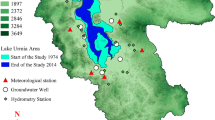Abstract
Predicting the dynamics of water-level in lakes plays a vital role in navigation, water resources planning and catchment management. In this paper, the Extreme Learning Machine (ELM) approach was used to predict the daily water-level in the Urmia Lake. Daily water-level data from the Urmia Lake in northwest of Iran were used to train, test and validate the employed models. Results showed that the ELM approach can accurately forecast the water-level in the Urmia Lake. Outcomes from the ELM model were also compared with those of genetic programming (GP) and artificial neural networks (ANNs). It was found that the ELM technique outperforms GP and ANN in predicting water-level in the Urmia Lake. It also can learn the relation between the water-level and its influential variables much faster than the GP and ANN. Overall, the results show that the ELM approach can be used to predict dynamics of water-level in lakes.




Similar content being viewed by others
References
Altunkaynak A (2007) Forecasting surface water level fluctuations of Lake Van by artificial neural networks. Water Resour Manag 21(2):399–408
Annema AJ, Hoen K, Wallinga H (1994) Precision requirements for single-layer feedforward neural networks. In: Fourth International Conference on Microelectronics for Neural Networks and Fuzzy Systems, 145–151
Buyukyildiz M, Tezel G, Yilmaz V (2014) Estimation of the change in lake water level by artificial intelligence methods. Water Resour Manag 28(13):4747–4763
Chevillon G, Hendry DF (2005) Non-parametric direct multi-step estimation for forecasting economic processes. Int J Forecast 21(2):201–218
Fan S, Hyndman RJ (2012) Short-term load forecasting based on a semi-parametric additive model. IEEE Trans Power Syst 27(1):134–141
Farmer JD, John J, Sidorowich S (1987) Predicting chaotic time series. Phys Rev Lett 59(8):45–848
Ghouti L, Sheltami TR, Alutaibi KS (2013) Mobility prediction in mobile Ad Hoc networks using extreme learning machines. Procedia Comput Sci 19:305–312
Huang GB, Zhu QY, Siew CK (2004) Extreme learning machine: a new learning scheme of feedforward neural networks. Int Joint Conf Neural Netw 2:985–990
Huang GB, Zhu QY, Siew CK (2003) Real-time learning capability of neural networks, Technical Report ICIS/45/2003, School of Electrical and Electronic Engineering, Nanyang Technological University, Singapore, April 2003
Huang GB, Zhu QY, Siew CK (2006) Extreme learning machine: theory and applications. Neurocomputing 70:489–501
Karimi S, Shiri J, Kisi O, Makarynskyy O (2012) Forecasting water level fluctuations of Urmieh Lake using gene expression programming and adaptive neuro- fuzzy inference system. Int J Ocean Clim Syst 3(2):109–125
Karimi S, Kisi O, Shiri J, Makarynskyy O (2013) Neuro fuzzy and neural network techniques for forecasting sea level in Darwin Harbor, Australia. Comput Geosci 52:50–59
Karunanithi N, Grenney WJ, Whitley D, Bovee K (1994) Neural networks for river flow prediction. J Comput Civ Eng 8(2):201–220
Kisi O, Shiri J, Nikoofar B (2012) Forecasting daily lake levels using artificial intelligence approaches. Comput Geosci 41:169–180
Kisi O, Shiri J, Karimi S, Shamshirband S, Motamedi S, Petković D, Hashim R (2015) A survey of water level fluctuation predicting in Urmia Lake using support vector machine with firefly algorithm. Appl Math Comput 270:731–743
Koza JR (1992) Genetic programming: on the programming of computers by natural selection. MIT Press, Cambridge, MA
Liang NY, Huang GB, Rong HJ, Saratchandran P, Sundararajan N (2006) A fast and accurate on-line sequential learning algorithm for feedforward networks. IEEE Trans Neural Netw 17:1411–1423
Marcellino M, Stock J, Watson MW (2006) A comparison of direct and iterated multistep AR methods for forecasting macroeconomic time series. J Econ 135:499–526
Martin C (1989) Nonlinear prediction of chaotic time series. Physica D 35:335–356
McSharry PE, Bouwman S, Bloemhof G (2005) Probabilistic forecasts of the magnitude and timing of peak electricity demand. IEEE Trans Power Syst 20:1166–1172
Nian R, He B, Zheng B, Heeswijk MV, Yu Q, Miche Y (2014) Extreme learning machine towards dynamic model hypothesis in fish ethology research. Neurocomputing 128:273–284
Ramanathan R, Engle RF, Granger CWJ, Vahid F, Brace C (1997) J Forecast 13:161–174
Sajjadi S, Shamshirband S, Alizamir M, Yee L, Mansor Z, Manaf AA, Altameem TA, Mostafaeipour A (2016) Extreme learning machine for prediction of heat load in district heating systems. Energy Build 122:222–227
Shamshirband S, Mohammadi K, Chen HL, Samy GN, Petković D, Ma C (2015) Daily global solar radiation prediction from air temperatures using kernel extreme learning machine: a case study for Iran. J Atmos Sol Terr Phys 134:109–117
Shiri J, Makarynskyy O, Kisi O, Dierickx W, FakheriFard A (2011) Prediction of short term operational water levels using an adaptive neuro-fuzzy inference system. J Waterw Port Coast Ocean Div ASCE 137(6):344–354
Singh R, Balasundaram S (2007) Application of extreme learning machine method for time series analysis. Int J Intell Technol 2:256–62
Sulaiman M, El-Shafie A, Karim O, Basri H (2011) Improved water level forecasting performance by using optimal steepness coefficients in an artificial neural network. Water Resour Manag 25:2525–2541
Vuglinskiy V (2009) Water Level: water level in lakes and reservoirs, water storage. Assessment of the status of the development of the standards for the terrestrial essential climate variables, Global Terrestrial Observing System (GTOS), Rome, Italy, pp 26
Wang X, Han M (2014) Online sequential extreme learning machine with kernels for nonstationary time series prediction. Neurocomputing 145:90–97
Yu Q, Miche Y, Séverin E, Lendasse A (2014) Bankruptcy prediction using extreme learning machine and financial expertise. Neurocomputing 128:296–302
Author information
Authors and Affiliations
Corresponding authors
Rights and permissions
About this article
Cite this article
Shiri, J., Shamshirband, S., Kisi, O. et al. Prediction of Water-Level in the Urmia Lake Using the Extreme Learning Machine Approach. Water Resour Manage 30, 5217–5229 (2016). https://doi.org/10.1007/s11269-016-1480-x
Received:
Accepted:
Published:
Issue Date:
DOI: https://doi.org/10.1007/s11269-016-1480-x




